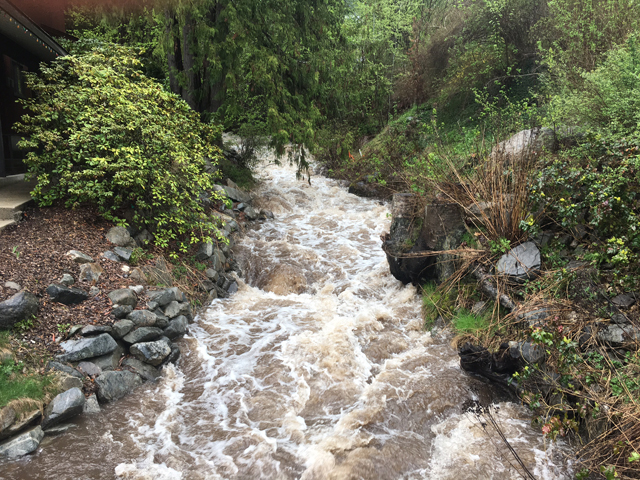Water users will ‘scrape by’, despite drought conditions
Water managers across the region say despite the two-month-old drought that’s gripped the Boundary and Kootenay areas, community and regional water supplies remain stable.
“Surprisingly, we’ve had no problems yet,” says Uli Wolf, the general manager for environmental services with the Regional District of Central Kootenay. “The creeks we are monitoring for water supply have held up reasonably well.”
Local, regional and provincial water officials contacted by thenelsondaily.com all say they’ve received no reports of community water systems- and there are hundreds in the Kootenays- failing because of the drought.
That’s despite the fact the West Kootenay has received less than 10 mm of rain since July 1- and some areas even less. The region has experienced its hottest, driest summer on record.
The RDCK manages water systems for about 19 settlements and communities. This summer, that job has been a bit of a rollercoaster.
“We went from flood management to drought management in one week,” says Wolf. “But we also went into the hottest, driest period with a maximum amount of water available.”
Wolf says the most worrisome water district for the RDCK was in the rural Creston area, which had supply problems a few years ago. But with the summer slipping away, and demand dropping as crops are harvested, Wolf says they figure they are through the worst of it.
“People have given up on having a green lawn,” he says. “Sunny hours are shorter, the days are shorter, the highest heat hours are shorter.
“We still need water, no doubt about it. But we will likely be able to scrape by without having to put in higher water use restrictions.”
It could be close. On Friday the province raised the drought danger level in the Boundary area, on the western border of the Kootenay region, to the highest level. And BC’s river forecasters say it’s likely to remain there for some time.
“We’ve seen things getting fairly low the last few weeks,” says Dave Chambers, the head of the province’s River Forecast Centre. Rivers like the Slocan are at a one-in-20-year low, while other streams are hitting a one-in-50-year low.
“So we are looking at flows that are half or three-quarters of what they would normally be for this time of year,” says Campbell. “It’s certainly quite dramatic.”
He also says water flows are low but remain stable, despite the drought, because of last winter’s higher-than-average snowpack, and the rains of spring.
By winter’s end, snowpack in higher elevations in some parts of the West Kootenay were 120 per cent of normal. Early spring rains caused flooding, but also pushed up natural reservoirs of water that systems are still benefitting from.
“The supply side is still doing ok,” says Campbell. “Even with the drought levels in the province, we’re not seeing the level of impacts that it should be having.”
Campbell says it would take about 100 mm of rain- or about two months of average rains- to bring systems back to a normal level. But Campbell isn’t particularly worried about the low river levels now.
“It’ s normally the time of year where flows are lowest, as we go out of the summer and into the winter,” he says. “It’s a normal pattern, but below what they should be.”
The region’s largest water control system, BC Hydro’s Columbia Basin system of dams and reservoirs, hasn’t seen any impact from the drought, says an official.
“We had a wet spring and there was a high snowpack last year, and that has moderated the impact of the recent dry weather,” says Jen Walker-Larsen, a stakeholder engagement advisor for communications with Hydro. “We were able to get the water from the snowpack melt and the wet spring into our reservoirs.
“That is really the beauty of the dam system, it lets you hold water back for when you need it.”
Walker-Larsen says the Kinbasket reservoir is about two metres below high-pool mark, and Arrow Lakes is just under full pool- and that’s after two years of below-normal reservoir levels there, she points out.
In the middle of a drought, it’s a strange state of affairs.
“A few months ago we were planning for excess water,” she says. “So I think you’re seeing that no matter how well you forecast, there always is the weather which adds uncertainty. You never know what will happen.”






















